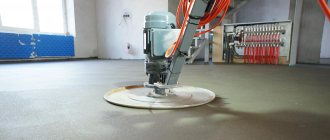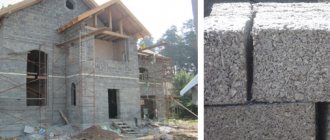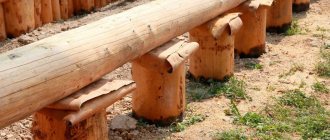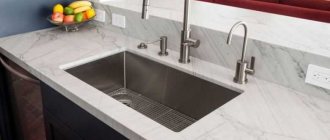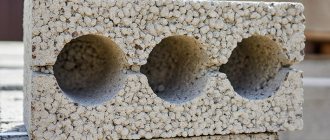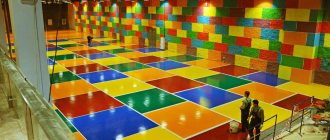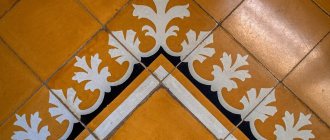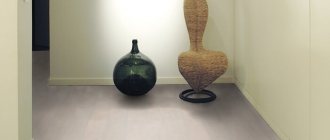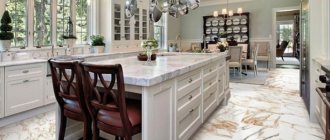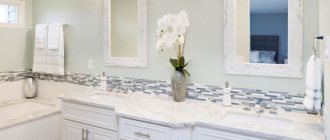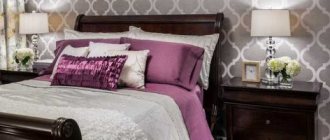Vinyl flooring is a relatively new type of finishing material, but with an impeccable reputation. The characteristics of vinyl combine the advantages and lack the disadvantages of laminate, wood and linoleum. It is able to withstand friction, heavy furniture and floods, therefore it is used in the design of offices, retail premises, medical institutions, etc.
To choose from: FineFloor quartz-vinyl tiles, Decoria, Holzplast interlocking tiles, Corkstyle vinyl laminate, Step Click eight-layer vinyl flooring, products from flooring masters - Wicanders, IVC Moduleo, Tarkett Art Vinyl, etc.
Vinyl flooring: varieties
- Self-adhesive tiles. Produced with a layer of glue under a layer of paper. All that remains is to remove the protective paper and, rolling it with a roller, glue the entire area of the coating to the base;
- Rolled fabric. Also stationary view. It is completely glued; special glue is used to fix the canvas;
- Tiles with locks on self-adhesive tape. Unlike the previous product, it is glued only along special protrusions on both sides of the tile;
- Vinyl cover with lock joint. Installed similarly to laminate, it is used in places where high wear resistance is required.
Structure
Vinyl coating is divided into two groups - quartz vinyl and pressed PVC coating. Quartz vinyl tiles contain quartz sand (80% of the composition), vinyl and plasticizers. PVC tiles are layers pressed on top of each other. In the simplest version there are 4 such layers. A reinforcing layer (fiberglass) is placed on top of the base vinyl layer, then there is a decorative layer under a transparent protective coating (vinyl film). The layers of vinyl coating are joined by hot pressing.
Purpose of layers:
- The surface film prevents impacts, scratches, and signs of wear. The wear resistance class of floors depends on this layer;
- The pattern that determines the design and color of the coating is applied using heliogravure or screen printing technology;
- Pressed quartz chips and plasticizing additives make the material strong, tough, and elastic;
- The PVC backing (vinyl) stabilizes the tiles and neutralizes vibration, so you can walk on the vinyl floor completely silently.
Elastic PVC coverings
Quartz vinyl tiles
The structure contains up to 80% compressed quartz sand, which simply serves as an environmentally friendly and inexpensive filler. To ensure that the quartz does not spill out and the floor covering remains stable, a layer of polyvinyl chloride, fiberglass, and optical fiber are introduced. Quartz vinyl retains elasticity and all the advantages of vinyl floors, however, the multilayer structure complicates production, which affects the cost of the finished product.
Installation methods:
► Interlocking vinyl laminate. Click locks are provided for installation around the perimeter of the plates. Thanks to strong and airtight joints, the floor covering does not need to be glued, and the tolerances for unevenness of the base are slightly increased due to the greater thickness.
► Adhesive PVC tiles. The plates are glued to the concrete screed using special contact adhesive. The thickness of adhesive quartz vinyl tiles is only 2-3 mm: a perfectly flat base is required.
The main advantage of quartz vinyl is its flexible structure and low weight : no substrate is needed, the coating absorbs impact noise (hum from steps, falling objects).
Among the disadvantages, we highlight the demanding nature of PVC tiles for the base, as well as the limitation on heating the surface when using a heated floor (26-28°C).
Advantages of vinyl coverings
Strength. Vinyl is chosen for its wear resistance and durability. It is plastic, not afraid of loads, heels, impacts and friction, does not paint or crack. It is important that fragments damaged during operation can be removed and replaced. In this regard, tile material is more profitable than sheet material.
Moisture resistance. Quartz-vinyl tiles are invulnerable to water, and the threat of leaks is minimal. This allows you to use vinyl flooring in the bathroom, toilet, and kitchen.
Easy care. Maintaining this floor is easy. Simply sweep away the debris and then wash with a wet mop. Appropriate cleaning compounds are used to remove contaminants.
Quick styling. Vinyl flooring is even laid on top of old floors - concrete, wood, or tile. The main thing is that there are no significant differences in height and protruding nails.
Durability. A properly assembled vinyl floor lasts 10-20 years; the service life directly depends on the quality of the material, the installation method and the characteristics of the room.
Aesthetics. The decorative properties of the material are excellent. Vinyl floors create exquisite beauty, and in terms of the richness of colors and patterns they have no equal. Among the popular models are printed tiles decorated with wood, marble, granite, terracotta and other materials with various shades, textures and textures.
Comfort. Regardless of the type of surface (it can be smooth or rough, matte or glossy), vinyl seems soft and resilient. It is pleasant to walk on such flooring, in addition, they remain warm in winter.
Vinyl tiles - what is it?
The first natural questions that arise from a buyer to whom a seller offers vinyl tiles are: what is it and what is it made from?
Vinyl, or more precisely polyvinyl chloride (PVC), is a chemical composite. This polymer has wide application in almost all spheres of human activity. It is distinguished by high density with good flexibility of the material. Naturally, such a polymer simply could not help but find application in the field of construction and finishing. In particular, several types of floor coverings are made from PVC.
Quartz Vinyl Floor Tiles
Modern modified vinyl flooring compounds also add natural materials, such as calcium and quartzite, obtained from sand and shell rock. Therefore, some varieties have acquired the name quartz-vinyl tiles.
Modern modified coatings also include other innovative additives, fillers and stabilizers that improve the performance characteristics of the floor covering. But at the same time, vinyl tiles are environmentally friendly materials, so they can be used in any residential premises. And the variety of color and texture options for external design allows you to choose floor coverings for any design of the room.
Types of vinyl flooring
Vinyl coverings are divided into different types according to their structure and installation technology.
Lock modules
Tiles equipped with a lock often have locking modules. This coating option is essentially the same laminate. But not based on wood composite, but based on PVC.
Laminated PVC boards with interlocking joint
Individual boards are assembled into a covering using interlocking joints operating on the “curved tongue and groove” principle. Ease of installation lies in the absence of the need to use adhesives or other fasteners.
Approximate diagram of the structural structure of interlocking vinyl laminate
1 – vinyl impact-resistant base.
2 – The main layer of the board is made of vinyl-quartz composite.
3 – stabilizing fiberglass reinforcing layer.
4 – decorative printed coating of the board, which determines its external design.
5 – one or more protective transparent wear-resistant layers, usually based on polyurethane.
Considering the characteristic rigidity of laminated boards, the base under this coating must be carefully leveled, otherwise squeaks will soon appear and locks may break. Under the laminate it is necessary to lay a substrate that will smooth out minor unevenness in the base.
The most common sizes of vinyl laminate boards are 920×180 and 920×100 millimeters.
Adhesive coating
Floor-mounted vinyl flooring is usually sold in flexible square or rectangular tiles of varying sizes. The structural structure of the material from different manufacturers may vary somewhat, but the basis is always a fairly thick layer of PVC, which is often given a foam structure - the material is softer and “warmer”.
Installation of vinyl tiles with adhesive applied to the base
Vinyl tiles are convenient because they can be installed in any pattern, creating various mosaic patterns on the floor.
Some diagrams that can be used when installing flexible vinyl tiles on adhesive.
Master at work - laying flooring from tiles of different sizes, shapes and colors
To lay such tiles you will need special glue, spatulas for applying it and a rubber roller for rolling the joints between the covering parts.
Rolled vinyl covering – PVC linoleum
The rolled version of vinyl covering is ordinary PVC linoleum. It can also be fixed to the base using the same glue, but very often it is simply laid on the floor, and the edges, after tracing and trimming, are covered with baseboards fixed to the walls. Laying linoleum is much easier and faster, but it cannot be used to create any patterns on the floor surface. This drawback, however, is mitigated by a wide range of decorative options.
Self-adhesive vinyl covering
This vinyl flooring option can also come in different shapes and sizes of pieces. The structural structure is almost the same as that of the considered modular coating laid on glue. The difference lies in the presence of an already applied lower adhesive layer, protected before installation with a special film. This backing is removed from each of the parts (lamellas) immediately before its installation.
PVC tiles with self-adhesive backing
The adhesive layer provided on such flexible panels is designed for installation of the coating on various relatively flat substrates - this can be a primed concrete surface, an old wooden floor or parquet or plywood (OSB), linoleum or ceramic tiles that require updating. When using this material, as well as when laying it on glue, no backing is used under it.
Modular coverings with “Smart tape”
The next option for vinyl covering is lamellas equipped on both sides with special adhesive strips, the so-called “Smart tape”.
Installation of vinyl tiles held together using “Smart tape”
This type of vinyl covering can be laid on a flat, dry surface made of any materials. The individual parts are fastened only to each other, without being fixed to the base, and this creates a so-called “floating” coating.
Laying this PVC floor is quite simple. Its installation will be described in detail in the instruction table below.
* * * * * * *
It must be said that recently large manufacturers have been using similar technologies to create a multilayer structure of the material to produce all flexible vinyl tiles. This structure gives the tile both the required elasticity and the necessary strength, allowing it to cope with even very significant external loads, including abrasive and abrasive effects.
For example, let's take a look at the structure of flexible PVC tiles from the Art Tile brand.
The structure of flexible PVC tiles "Art Tile"
1 – external wear-resistant polyurethane coating. Often micro-relief embossing is done on it to prevent slipping on the surface.
2 – the second protective layer, in this case – corundum.
3 – a layer of protection against ultraviolet rays.
4 - a decorative layer with a printed pattern, usually with a high-quality imitation of the texture of wood or (less often) natural stone.
5 and 7 – the main balance quartz-vinyl layers, with a stabilizing reinforcing layer of fiberglass ( 6 ) between them.
8 – the so-called vibroacoustic layer, which determines the high sound insulating abilities of the material.
9 – PVC base (base layer). In many models, as we have seen, it is replaced either with a self-adhesive layer or with smart mounting tape.
Classification of vinyl coatings by wear resistance
When choosing a vinyl coating, you need to pay special attention to the wear resistance class, since it determines how long it will last without losing its decorative qualities.
This property is determined by the class of the material.
If we are talking about quartz-vinyl tiles, then you can refer to the following table
Table of wear resistance classes of quartz-vinyl tiles
- 21÷22 class of material has a small thickness, as well as a weak protective coating, can be used in residential premises with low traffic intensity.
- 23 ÷ 31 grade vinyl tiles have a higher degree of wear resistance, can be used in rooms with heavy traffic, such as a hallway or kitchen. The service life of the coating in such conditions is about seven years;
- 32÷33 class of material is suitable for residential premises with increased load on floors, for offices or offices of public organizations with moderate traffic. The service life of the coating is 10÷12 years, the thickness of the protective film of the tile is 0.2 mm;
- Class 34 tiles have a maximum thickness of 3.2 mm and a protective outer film 0.3 mm thick, hence the high degree of wear resistance. The material can be laid both in living rooms and in public buildings. Durability in residential premises - 10÷15 years, in public buildings - 7÷10 years;
- 41÷43 class is a commercial type of tile, which is not used in residential construction - there are no adequate loads. The thickness of the protective film is 0.5 mm, the service life of the coating varies from 15 to 20 years.
Interlocking vinyl flooring is classified similarly to regular laminate flooring.
Table of classification of laminate according to the degree of wear resistance
Similarly, the higher the class of flooring, the longer it will last, but at the same time its cost increases.
Based on considerations of expediency, you should not choose the most durable and expensive commercial material for flooring in residential premises. For example, for rooms with a high intensity of movement of people - an entrance hall, a corridor or a kitchen, 31÷32 of both laminate and tiles is suitable. For other rooms, the best option would be flexible tiles 23÷31 or laminate 23 or 31 . And judging by the analysis of demand, the most popular is 32 , as it is almost universal for a house or apartment.
Advantages and disadvantages of the material
In fact, the advantages and disadvantages of any material directly indicate its operational capabilities. Therefore, it is very important to pay close attention to them.
The positive aspects of vinyl flexible modules include their following qualities:
- The coating, thanks to its high density and the presence of a quartz additive, is not pressed through by the legs of pieces of furniture or the heels of shoes - no marks are left.
High moisture resistance of the coating, of course, is only possible with proper installation of parts
- High moisture resistance of the coating - it is not afraid of not only humidity, but also spilled water.
- The pleasant, warm vinyl surface is comfortable when walking barefoot.
- Unlike laminate, vinyl tiles do not create a “ringing floor” effect.
- Such floor tiles can be used to decorate walls, where appropriate.
- Tiles belonging to class 32 and above show very good resistance to abrasion loads.
- The coating does not ignite if a hot coal from a fireplace or a dropped cigarette falls on it;
- PVC is an environmentally friendly material, as it does not release toxic substances into the environment during operation.
Quartz-vinyl tiles do not absorb odors and are not susceptible to damage from cat claws
- The material does not absorb odors, which is important when pets live in a house or apartment;
- Attracts a variety of design solutions, patterns and colors, the relatively affordable cost of the material;
- An important “plus” for many is the ease of self-installation of the coating;
- The floor surface is easy to clean from contaminants;
- It is possible to repair a damaged area of the floor without completely replacing the flooring;
- Quartz-vinyl tiles belong to the KM3 and KM5 fire protection classes. They are characterized by low flammability and smoke production - this indicator depends on the manufacturer of the material.
Information about the shortcomings of a material is sometimes even more necessary than information that describes its positive aspects. So, the “disadvantages” of vinyl are its following features:
Freshly unpacked vinyl tiles have an unpleasant chemical smell
- The new material does not have a particularly pleasant smell. This is due to the use of certain chemical additives in the production of polyvinyl chloride. But after laying the tiles, the smell gradually disappears;
- The most thorough preparation of the base for installation of tiles is required. But this process is necessary for almost any floor covering, so it can be called one of the stages of work.
- Rubber marks remain on the vinyl surface - from heels, wheels of chairs and tables, as well as rubber-based carpets;
- Low-quality material quickly takes on an unsightly appearance, especially under the influence of ultraviolet rays. Therefore, having chosen a coating, you should ask the seller for a certificate of product compliance with all established standards.
Disadvantages of Vinyl Flooring
Despite the impressive list of advantages, vinyl flooring is not 100% flawless. Durable, affordable and beautiful, it still has certain disadvantages. And the most obvious of them relates to the impact on the environment. Plasticizers and stabilizers in the composition do not make vinyl floors environmentally friendly and 100% natural materials. Vinyl does not rot, but its natural destruction takes a lot of time. In addition, it is rarely recycled.
Other features:
- Insulation. Thin vinyl tiles are almost often additionally insulated, which increases costs;
- Softness. Vinyl can suffer a lot of wear and tear if it is laid over a defective subfloor. It is better to level the base to avoid scuffs and damage to the coating;
- Toxicity. Materials in quartz vinyl tiles sometimes release toxic compounds. This can cause irritation to the eyes and respiratory system. The main degassing occurs immediately after the deck is assembled;
- Color. Vinyl is susceptible to chemical pigmentation and can change color - for example, by reacting with rubber. Rugs and soles can, over time, trigger a chemical reaction that will result in discoloration of certain areas of the floor. Poor quality material can turn yellow when exposed to sunlight or pollution. To avoid such surprises, you should choose high quality products.
Return to list
How to choose a laminate
When choosing a floor covering, you need to pay attention to the following parameters:
- the advantages that this or that type of material has;
- features of installation and operation,
- prices, and their dependence on quality and consumer properties.
You can give preference to this type of flooring if you plan to lay it in your favorite bathhouse, bathtub or shower - moisture is not a problem for vinyl laminate. And caring for the floor doesn’t seem difficult either. However, you need to be careful if it is covered in rooms where open fire is possible: in the kitchen or near a fireplace that is heated with wood.
Everyone will choose the color composition and type of ornament according to their wishes and in accordance with their own ideas about beauty and comfort.
You can give preference to this type of flooring
As for the installation features, they also need to be taken into account when determining whether to carry out all the necessary operations yourself or turn to the services of specialists. If you do not have the skill to carry out work of this kind, it is better to entrust it to a specialist. In addition, you will have to decide which way is best to lay the new floor, which will affect the choice of material: adhesive or interlocking. You can also use self-adhesive tiles to gain the necessary working skills.
Advice. Do not rush to buy very cheap material, because the price directly depends on the type and quality of the coating. Therefore, you need to be quite careful and carefully calculate the upcoming expenses, taking into account that an inexpensive material will have a much shorter service life, since it may not be as durable as expected.
Do not rush to buy very cheap material, because the price directly depends on the type and quality of the coating
